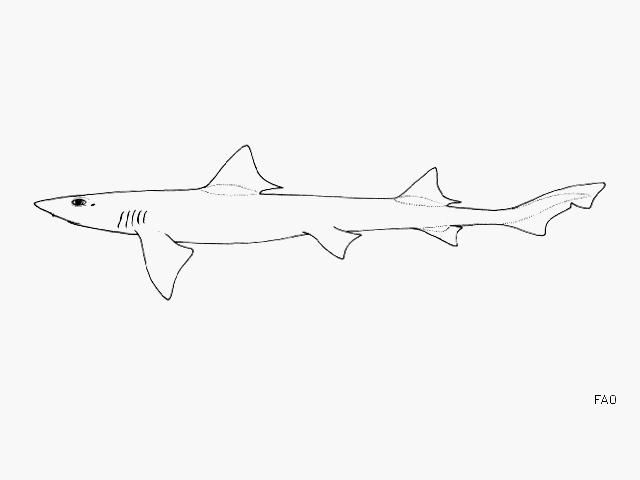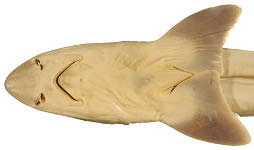Mustelus antarcticus
Günther, 1870
Gummy shark
Classification: Elasmobranchii Carcharhiniformes Triakidae
Reference of the original description
Catalogue of the fishes in the British Museum. London, British Museum(Natural History). Vol. 8: 549 p.
Catalogue of the fishes in the British Museum. London, British Museum(Natural History). Vol. 8: 549 p.
Image of the original description
No image in first description.
No image in first description.
Synonyms / new combinations and misspellings
Emissola antarctica, Emissola ganearum, Emissola maugeana, Galeorhinus antarcticus, Galeus antarcticus, Mustelus walkeri
Emissola antarctica, Emissola ganearum, Emissola maugeana, Galeorhinus antarcticus, Galeus antarcticus, Mustelus walkeri
Types
Mustelus antarcticus
Syntype: BMNH: 1868.8.18.5 Tasmania BMNH: 1869.6.7.1 New South Wales BMNH: 1843.11.20.3 Land of Admiralty, BMNH: 1823.2.10.12 New Zealand BMNH: 1843.11.20.4 Land of Admiralty, BMNH: 1843.11.20.2 Land of Admiralty,
Emissola ganearum
Holotype: AMS: IB.1630; Paratype: AMS: E.2316; AMS: IA.672;
Emissola maugeana
Holotype: AMS: IA.1922;
Mustelus walkeri
Holotype: CSIRO: H 460-02; Paratype: CSIRO: H 632-02; CSIRO: H 705-01; CSIRO: H 2471-02; CSIRO: H 3643-20; CSIRO: H 2469-02; CSIRO: H 2471-01; CSIRO: H 1367-01; CSIRO: H 2468-01; CSIRO: H 2469-01; CSIRO: H 1362-01; CSIRO: H 1362-02; CSIRO: H 1310-04; CSIRO: H 1310-05; CSIRO: H 1310-06; CSIRO: H 459-02; QM: I 38198;
Mustelus antarcticus
Syntype: BMNH: 1868.8.18.5 Tasmania BMNH: 1869.6.7.1 New South Wales BMNH: 1843.11.20.3 Land of Admiralty, BMNH: 1823.2.10.12 New Zealand BMNH: 1843.11.20.4 Land of Admiralty, BMNH: 1843.11.20.2 Land of Admiralty,
Emissola ganearum
Holotype: AMS: IB.1630; Paratype: AMS: E.2316; AMS: IA.672;
Emissola maugeana
Holotype: AMS: IA.1922;
Mustelus walkeri
Holotype: CSIRO: H 460-02; Paratype: CSIRO: H 632-02; CSIRO: H 705-01; CSIRO: H 2471-02; CSIRO: H 3643-20; CSIRO: H 2469-02; CSIRO: H 2471-01; CSIRO: H 1367-01; CSIRO: H 2468-01; CSIRO: H 2469-01; CSIRO: H 1362-01; CSIRO: H 1362-02; CSIRO: H 1310-04; CSIRO: H 1310-05; CSIRO: H 1310-06; CSIRO: H 459-02; QM: I 38198;
Description :
Citation: Mustelus antarcticus Günther, 1870: In: Database of modern sharks, rays and chimaeras, www.shark-references.com, World Wide Web electronic publication, Version 12/2025
Please send your images of "Mustelus antarcticus" to info@shark-references.com

Mustelus antarcticus Günther, 1870, © FAO, www.fish-base.org

Mustelus antarcticus Günther, 1870, © FAO, www.fish-base.org
Common names
 Australischer Glatthai,
Australischer Glatthai,  Gummihai,
Gummihai,  Musola,
Musola,  Musola austral,
Musola austral,  Emissole gommée,
Emissole gommée,  Australian smooth hound,
Australian smooth hound,  Flake,
Flake,  Gummy shark,
Gummy shark,  Smooth dog-shark,
Smooth dog-shark,  Smooth hound dogfish,
Smooth hound dogfish,  Spotted gummy shark,
Spotted gummy shark,  Sweet William,
Sweet William,  White-spotted gummy shark,
White-spotted gummy shark,  Palombo antartico,
Palombo antartico,  Cacao antárctico,
Cacao antárctico,  Caçao-antárctico
Caçao-antárctico
 Australischer Glatthai,
Australischer Glatthai,  Gummihai,
Gummihai,  Musola,
Musola,  Musola austral,
Musola austral,  Emissole gommée,
Emissole gommée,  Australian smooth hound,
Australian smooth hound,  Flake,
Flake,  Gummy shark,
Gummy shark,  Smooth dog-shark,
Smooth dog-shark,  Smooth hound dogfish,
Smooth hound dogfish,  Spotted gummy shark,
Spotted gummy shark,  Sweet William,
Sweet William,  White-spotted gummy shark,
White-spotted gummy shark,  Palombo antartico,
Palombo antartico,  Cacao antárctico,
Cacao antárctico,  Caçao-antárctico
Caçao-antárctico
Short Description
Diagnosis after Compagno, 1984 [517]: Body fairly slender. Head short, prepectoral length 17 to 21% of total length; snout moderately long and bluntly angular in lateral view, preoral snout 5.7 to 7.4% of total length, preorbital snout 5.8 to 7.8% of total length; internarial space broad, 2.6 to 3.2% of total length; eyes fairly large, eye length 1.6 to 3.2 times in preorbital snout and 2.4 to 4.2% of total length; interorbital space fairly broad, 3.7 to 5.1% of total length; mouth short, its length subequal to eye length and 3.0 to 3.6% of total length; upper labial furrows considerably longer than lowers and 2.0 to 2.8% of total length; teeth molariform and asymmetric, with cusp reduced to a low point; buccopharyngeal denticles confined to tongue and anteriormost part of palate. Interdorsal space 19 to 23% of total length; trailing edges of dorsal fins denticulate, without bare ceratotrichia; pectoral fins moderately large, length of anterior margins 12 to 16% of total length, width of posterior margin 8 to 13% of total length; pelvic anterior margins 6.2 to 7.9% of total length; anal height 2.5 to 4.4% of total length; anal-caudal space greater than second dorsal height, 6.9 to 8.3% of total length; ventral caudal lobe more or less falcate in adults. Crowns of lateral trunk denticles lanceolate, with longitudinal ridges extending at least half their length. Cranium, hyomandibulae and scapulocoracoids not hypercalcified in adults; palatoquadrates not subdivided; monospondylous precaudal centra 35 to 38, diplospondylous precaudal centra 39 to 50, precaudal centra 76 to 86. Colour grey or grey-brown, above, light below, usually with numerous small white spots but without dark spots or dark bars. Development ovoviviparous.
Diagnosis after Compagno, 1984 [517]: Body fairly slender. Head short, prepectoral length 17 to 21% of total length; snout moderately long and bluntly angular in lateral view, preoral snout 5.7 to 7.4% of total length, preorbital snout 5.8 to 7.8% of total length; internarial space broad, 2.6 to 3.2% of total length; eyes fairly large, eye length 1.6 to 3.2 times in preorbital snout and 2.4 to 4.2% of total length; interorbital space fairly broad, 3.7 to 5.1% of total length; mouth short, its length subequal to eye length and 3.0 to 3.6% of total length; upper labial furrows considerably longer than lowers and 2.0 to 2.8% of total length; teeth molariform and asymmetric, with cusp reduced to a low point; buccopharyngeal denticles confined to tongue and anteriormost part of palate. Interdorsal space 19 to 23% of total length; trailing edges of dorsal fins denticulate, without bare ceratotrichia; pectoral fins moderately large, length of anterior margins 12 to 16% of total length, width of posterior margin 8 to 13% of total length; pelvic anterior margins 6.2 to 7.9% of total length; anal height 2.5 to 4.4% of total length; anal-caudal space greater than second dorsal height, 6.9 to 8.3% of total length; ventral caudal lobe more or less falcate in adults. Crowns of lateral trunk denticles lanceolate, with longitudinal ridges extending at least half their length. Cranium, hyomandibulae and scapulocoracoids not hypercalcified in adults; palatoquadrates not subdivided; monospondylous precaudal centra 35 to 38, diplospondylous precaudal centra 39 to 50, precaudal centra 76 to 86. Colour grey or grey-brown, above, light below, usually with numerous small white spots but without dark spots or dark bars. Development ovoviviparous.
Distribution
Eastern Indian Ocean: endemic to southern Australia, from Western Australia through Bass Strait to Tasmania and northern New South Wales. Possibly extends northward to southern Queensland and Shark Bay in Western Australia. Confused with another undescribed species whose southern distribution extends to Dampier (20°40"quot;S) (possibly Shark Bay) in the west and Bowen (20°S) (possibly Coffs Harbor) in the east. There is a single stock of gummy sharks in the area, however, regional stock differences might still exist. Source: www.gbif.org
Eastern Indian Ocean: endemic to southern Australia, from Western Australia through Bass Strait to Tasmania and northern New South Wales. Possibly extends northward to southern Queensland and Shark Bay in Western Australia. Confused with another undescribed species whose southern distribution extends to Dampier (20°40"quot;S) (possibly Shark Bay) in the west and Bowen (20°S) (possibly Coffs Harbor) in the east. There is a single stock of gummy sharks in the area, however, regional stock differences might still exist. Source: www.gbif.org
Human uses
fisheries: commercial; gamefish: yes
fisheries: commercial; gamefish: yes
Biology
Ovoviviparous but aplacental, with 1 to 38 pups. Embryos feed solely on yolk [733]. Gestation period ranges from 11-12 months. Newborn and juvenile gummy sharks aggregate in many areas across southern Australia but it is not known whether they inhabit defined shallow-water nursery areas. Ovulation takes place in Oct.-Dec. or Nov.- Feb. (WA). Parturition is complete by the following Dec. (Ref. 6390). The sharks are born at 30-35 cm [1388]. Occurs on the continental shelf and slope (Ref. 75154). Newborn and juvenile gummy sharks are found in many areas across southern Australia, but no well-defined nursery areas have been identified. These sharks are capable of long migrations, females travelling longer distances than males (Ref. 6390).
Ovoviviparous but aplacental, with 1 to 38 pups. Embryos feed solely on yolk [733]. Gestation period ranges from 11-12 months. Newborn and juvenile gummy sharks aggregate in many areas across southern Australia but it is not known whether they inhabit defined shallow-water nursery areas. Ovulation takes place in Oct.-Dec. or Nov.- Feb. (WA). Parturition is complete by the following Dec. (Ref. 6390). The sharks are born at 30-35 cm [1388]. Occurs on the continental shelf and slope (Ref. 75154). Newborn and juvenile gummy sharks are found in many areas across southern Australia, but no well-defined nursery areas have been identified. These sharks are capable of long migrations, females travelling longer distances than males (Ref. 6390).
Size / Weight / Age
157 cm TL (male/unsexed; [517]); 175 cm TL (female); max. published weight: 30.8 kg (Ref. 40637); max. reported age: 16 years (Ref. 6390)
157 cm TL (male/unsexed; [517]); 175 cm TL (female); max. published weight: 30.8 kg (Ref. 40637); max. reported age: 16 years (Ref. 6390)
Habitat
demersal; oceanodromous [17660]; marine; depth range ? - 350 m [1388], usually ? - 80 m [1388]
demersal; oceanodromous [17660]; marine; depth range ? - 350 m [1388], usually ? - 80 m [1388]
Remarks
shark-references Species-ID=3780;
shark-references Species-ID=3780;
Parasites (arranged by Jürgen Pollerspöck)
Myxosporea
Monogenea
Cestoda
Nematoda
Copepoda
Isopoda
Hirudinea
Myxosporea
Monogenea
- Calicotyle stossichi Braun, 1899 [17436]
- Empruthotrema dasyatidis Whittington & Kearn, 1992 [17002]
- Erpocotyle antarctica (Hughes, 1928) [17150] [22557] [16602]
- Macrophyllida antarctica (Hughes, 1928) Johnston, 1930 [17150]
- Triloculotrema japanicae Kearn, 1993 [17002]
Cestoda
- Calliobothrium tylotocephalum Alexander, 1963 [16602]
- Calliobothrium verticillatum (Rudolphi, 1819) [16602]
- Coronocestus coronatus (Robinson, 1959) [16602]
- Diesingium antarcticum (Campbell & Beveridge 1988) [16279] [16112]
- Dollfusiella australis Prudhoe, 1969 [16252] [16112]
- Dollfusiella martini (Beveridge, 1990) [16252] [16112]
- Dollfusiella ocallaghani (Beveridge, 1990) Beveridge & Jones, 2000 [16252] [16112]
- Lacistorhynchus dollfusi Beveridge & Sakanari, 1987 [16253] [16112] [15747]
- Molicola sp. [16112]
- Nybelinia thyrsites Korotaeva, 1971 [17845] [16112]
- Orygmatobothrium musteli (Van Beneden, 1850) [16602]
- Phyllobothrium lactuca Van Beneden, 1850 [16385] [16602]
- Platybothrium sp. [16306]
- Scyphophyllidium musteli (Van Beneden, 1850) [16306] [16443]
- Scyphophyllidium rodmani (Ruhnke & Carpenter, 2008) [7416]
- Symcallio eschrichti (Van Beneden, 1850) [16602]
- Symcallio hayhowi (Nasin, Caira & Euzet, 1997) [16201] [21796]
- Trimacracanthus aetobatidis (Robinson, 1959) [16252] [16112] [17404]
Nematoda
- Acanthocheilus rotundatus (Rudolphi, 1819) [16602] [16939] [17029]
- Pulchrascaris chiloscyllii (Johnston & Mawson, 1951) [17029]
- Terranova antarctica Leiper & Atkinson, 1914 [17139] [16602] [17029]
Copepoda
Isopoda
- Elthusa raynaudii (Milne Edwards, 1840) [16602]
Hirudinea
- Branchellion australis Leigh-Sharpe, 1916 [16602] [28595]
- Pontobdella leucothela Schimarda, 1861 [28595]


















